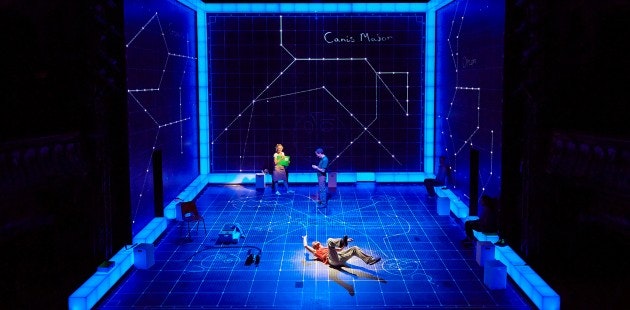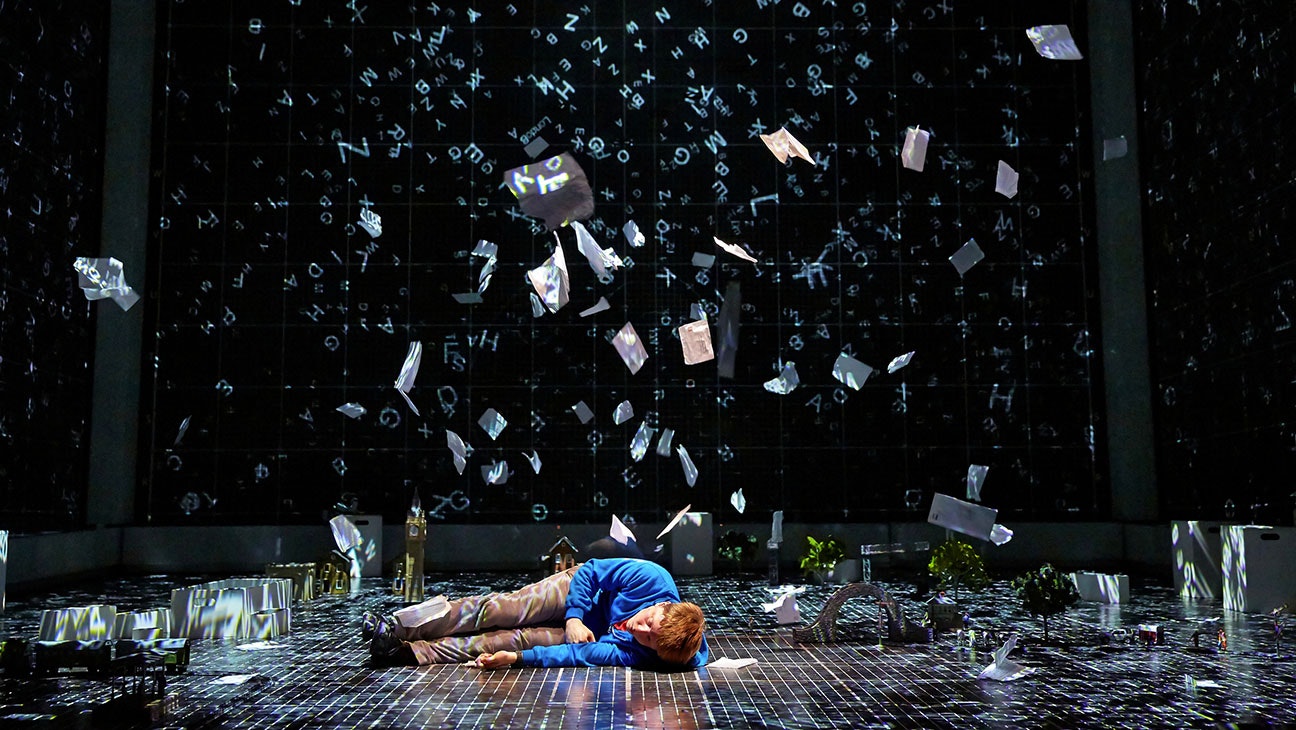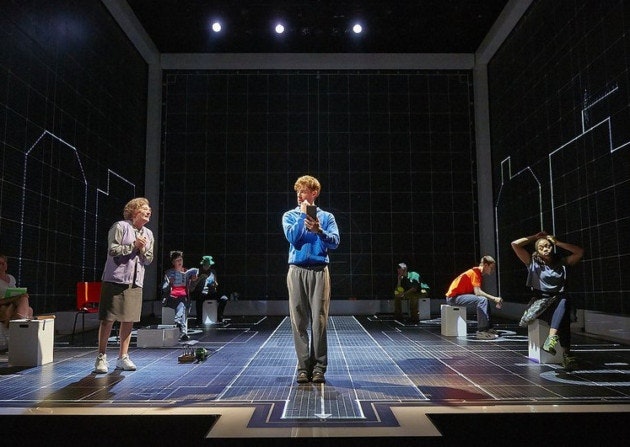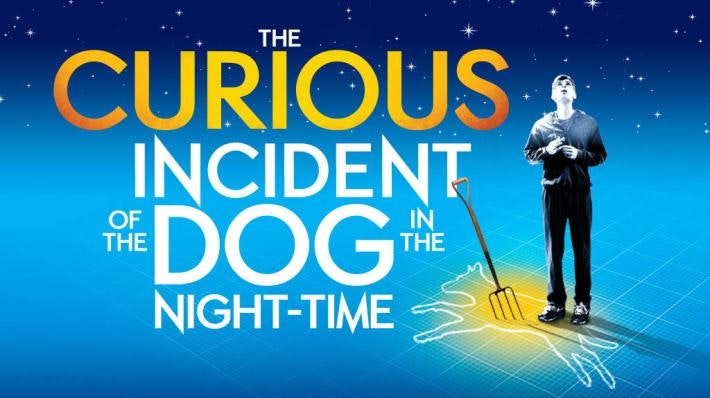The Curious Incident of the Dog in the Night-Time at the Gielgud Theatre
The National Theatre's award-winning production is based on Mark Haddon’s award-winning novel, adapted by Simon Stephens and directed by Marianne Elliott. The production has won 7 Olivier Awards including Best Play in 2013.
The main feature of the set for the show was a black grid spanning the back, floor and sides of the stage. This all encompassing backdrop proved extremely versatile, providing not just a surface for the extremely clever and visually stunning projections but also various trap doors and concealed panels. Projections included dot to dot style drawn houses to represent a street, collages of numbers streaming down and black and white images from a train window to name just a few. There were times when the floor and wall panels seemed to interact though whether these were actually interactive panels or done cleverly though projection mapping and rehearsal I was unsure. However these moments were regardlessly magical, perhaps a chalk drawing made on the floor, appearing simultaneously on the back wall or the actors mapping a route in the floor which appeared on the walls.

However there was a very narrow view of the stage for a lot of the audience and everyone appeared to be missing some element, a wall, the floor the top of the projection. It would be interesting to see this show again from a very different seat to discover if this makes a difference. I was slightly surprised this theatre with its exceptionally deep circle was being used for such a long residency of this particular show. This may be a case when the show will actually be better on tour, regionally in 2015 when it will be playing in more modern and open venues.
Form the beginning I was enamoured by the morphing nature of the set. At times on the surface appearing simple or sparse but then transforming to reveal a scene in new and clever ways. Everything was geared towards the mathematical main character Christopher, and his unique experience and observations of the environment around him. With a desire for clean and order disrupted by a confusing and busy world. Key props included a set of white box stools which were utilised to their extreme, they could be placed in many configurations, stacked and some even lit up. There main moment occurred when they were used to show the interiors of houses on the street with one lighting up in green to represent a TV, the next stacked high and lighting up in red as a microwave and the third placed landscape and lit in blue as a fish tank. This simple use of colour, light and composition combined with performance demonstrated both space and character quickly and effectively, with a touch of humour.
Another very important and reoccurring prop was a train set. This toy was established early on as part of Christopher's character, a favourite plaything in school and a key part of his routine. We later learn this also has emotional significance for his mother, adding deeper feelings and relevance. We became used to seeing Christopher handling this toy so when he became stressed about his plans it felt right that his play became more frantic. He began placing not just track but houses which were pulled from trapdoors in the floor as he built a scene. Although as an audience we saw this scene building, we still imagined a toy, so it proved a moment of true theatre magic when this scene finally revealed itself as London prior to the end of the first act. Enhanced by lighting, as the houses and track magically lit up and looked like London from the perspective, perhaps of a plane coming into land at night. This was a spectacular finale to the first act and also laid the concept for the start of his big journey in Act 2.
The actors performances were all generally very good, they showed the range of characters in a town and were easily recognisable, if at times a little stereotypical. The main character Christopher in particular was played exceptionally well, with believability and obvious research of character. Having personally worked closely with young people with autism I was totally convinced by his manner which included key details in his posture, reactions and tension in his fingers. The parent characters were often very frustrating, which to some extent worked with the story but at times lacked sensitivity, with too much shouting and aggression towards a vulnerable son, who they know is sensitive to sound and confrontation. Christopher's stress points in the story were highlighted by his manner and also emphasised by light, projections and sound, which created his confusing atmosphere and took us into his mind or generated a shocking impact such as when his Dad hits him.
Repetition in the text was used to represent his characters, autistic tendencies, his interests and obsessions in the world. These were often shown and emphasised through objects for example the contents of his pockets pulled out on a string. This demonstrated his heightened awareness to certain things and an intense observation of the world. By showing the objects it let us as an audience also be aware of these things and perhaps obsess about these small things, such as a leaf stuck to the bottom of a shoe.
The sequence mapping of Christopher's journey to London was highly dramatic and tense. Through the clever use of projection, physical movements and an intense sound track we felt his confusion, fear and determination. In particular the almost dance like physical interactions between the chorus of crowds and Christopher, was both beautiful and effective. We see him jostled, turned, bumped, spun and even lifted in the air by this crowd of unfamiliar strangers.

Towards the end of the show there was a moment when the actors broke the fourth wall and spoke directly to the audience. This was at first quite a surprise but was actually highly effective in bringing the character Christopher into reality. This was further emphasised when he returned after the show had supposedly finished and told us how he solved the mathematical equation. He commented on the equipment used to create the sophisticated and clever technology used within the show, such as projections and effects.
This was a highly enjoyable piece of theatre, which had humour, tension and emotion throughout the plot. The performances were matched with clever, contemporary and innovative design and an exceptionally creative and original use of technology. Personally I loved the book so felt a close relationship with both the characters and story, so was impressed that the believably throughout the show stood up to my critical eye.


